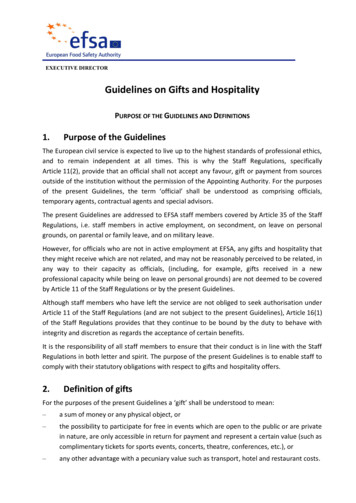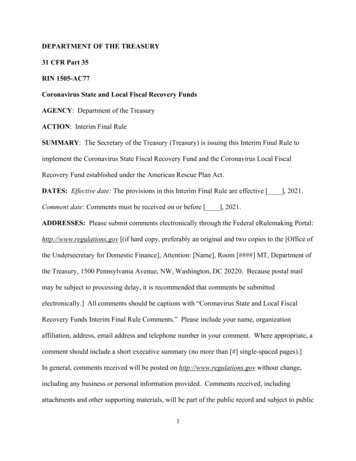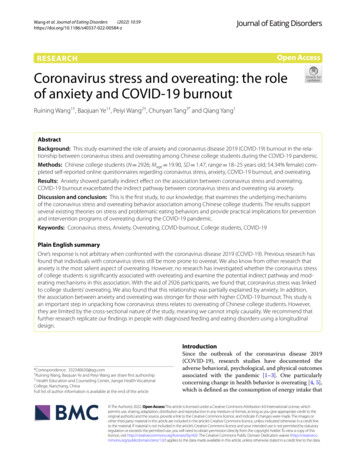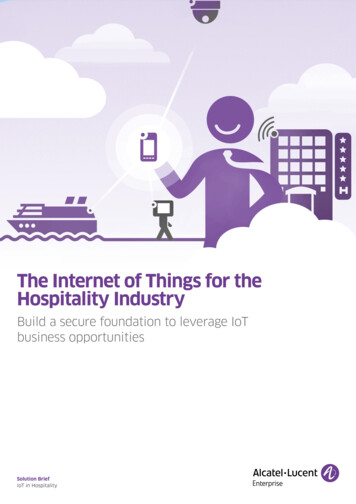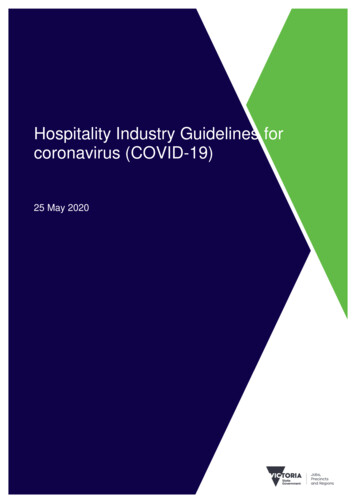
Transcription
Hospitality Industry Guidelines forcoronavirus (COVID-19)25 May 2020
CONTENTS12Introduction . 31.1Context. 31.2Purpose. 31.3Consultation . 3Coronavirus (COVID-19) Hospitality Guidelines . 42.1Guidance on development of plans . 42.2Environmental measures including cleaning . 52.3Floorplan and patron limits . 112.4Staff and training . 142.6Compliance and enforcement . 232.7Other . 24APPENDIX - checklists . 262
1 Introduction1.1ContextThe Victorian Government, alongside National Cabinet, has started a process to ease the restrictions thatwere put in place to help slow the spread of coronavirus (COVID-19). This will be a careful and stagedprocess.The roadmap put forward by National Cabinet for this process allows each jurisdiction to decide whichrestrictions can be eased and when, based on public health advice and local circumstances. Toappropriately manage the opening of facilities and venues, operators will need to comply with a range ofrequirements specified in legal directions.With the easing of restrictions, Victorians will be asked to play their part to keep one another safe – thisincludes maintaining a distance of at least 1.5 metres from each other, practising good hygiene and stayinghome even if slightly unwell.The Victorian Government will work in partnership with industry and unions to prepare for each step of theeasing of restrictions.The Victorian Government has announced that, from 11:59pm on 31 May 2020, cafes, restaurants and pubscan resume serving meals using table service only, for up to 20 customers at a time (a restaurant that hasdifferent dining areas/rooms may have up to 20 customers in each separate dining area, subject to densityrestrictions).1.2PurposeThis document is intended to assist hospitality businesses to prepare to safely resume operations inaccordance with the easing of restrictions, while also ensuring the public feels confident that their health andsafety is being protected.1.3ConsultationThe Victorian Government has consulted with a range of industry and union stakeholders in the developmentof these guidelines, including: Victorian Chamber of Commerce and IndustryAi GroupVictorian Trades Hall CouncilUnited Workers UnionShop, Distributive and Allied EmployeesAssociationVictorian Tourism Industry CouncilAustralian Hotels AssociationAustralian Retailers AssociationRestaurant and Catering VictoriaRSL Victoria Branch Community Clubs VictoriaWine VictoriaShopping Centre Council AustraliaProperty Council of AustraliaArts Industry Council of VictoriaMusic VictoriaMunicipal Association of VictoriaRegional Cities VictoriaRural Councils VictoriaPeriurban Group of Rural CouncilsVarious public arts and creative entities3
2Coronavirus (COVID-19) Hospitality Guidelines2.1 Guidance on development of plansEach venue is unique and should develop a tailored plan based on the information contained in this guide.The below information, checklists and FAQs should assist businesses in creating a bespoke plan for eachbusiness to be safe for employees and customers.SUMMARY OF KEY ACTIONSWhat you needto do to safelyre-open yourhospitalitybusinessWHO Protect staff wellbeing by ensuring safety and hygienemeasures are in place as well as ensuring workers arecomplying with health advice and are not unwell.Business Staff have been offered the Victorian Government COVID19 training (from 1 June)Business Have provisions in place to record patrons’ contact detailson booking or entry, with name and a contact number (thedetails of every patron should be recorded, not just oneevery table).Business Undertake a deep clean of the premises and implementadditional hygiene and cleaning measures and practicesBusiness Ensure venue is set up to adhere to patron and table sizelimits, and physical distancing of dining groups of:Businessa. capacity limits of 20 patrons per separate dining space(not including staff);b. density quotient of 1 patron per 4 square metres offloor space accessible to patrons; andc.tables to have no more than six patrons and arrangedso that patrons from different tables are not closerthan 1.5 metres when seated. Ensure patron awareness of, and compliance with,requirements (including collection of contact information).Business Be ready to work with the Department of Health andHuman Services in the event of a case of coronavirus(COVID-19) in a staff member or patron, or an outbreakaffecting your business.Business Complete and consider displaying coronavirus (COVID-19)Checklists provided in these Guidelines.Business Prepare signage to display at your venue.BusinessRelevant fact sheets, templates and downloadable signage for hospitality businesses are available at theBusiness Victoria website www.business.vic.gov.au4
2.2Environmental measures including cleaning2.2.1 DescriptionBusinesses are encouraged to have a plan that takes into account coronavirus (COVID-19) guidance fromWorkSafe Victoria and the guidelines contained in this document.Additional hygiene measures are a priority. While these additional measures will vary between venues, aperson who owns, controls or operates a food and drink facility which involves members of the publicentering any single undivided indoor or outdoor space, must, at a minimum: Undertake initial pre-opening deep cleaning and implement an environmental cleaning schedule toensure frequent cleaning and disinfection of high touch surfaces and bathrooms. Further adviceabout cleaning can be found at www.business.vic.gov.au. Display a sign at each public entry that includes information on the maximum number of people thatcan be in the space at a single time. Display posters on good hygiene and handwashing practices in prominent places and establishhygiene stations (with hand sanitiser) at entrances and throughout the venue to encourage handhygiene of staff and patrons. Maximise ventilation where possible. Provide physical barriers or floor markings to ensure physical distancing is maintained at cashiers, orconsider installation of sneeze guards. Limit dine-in service to table service only (i.e. no communal self-serve stations). Reduce touch points where possible, such as using contact-less payments, laminated menus thatcan be cleaned in between each use, minimising condiments on tables and removing communal andself-service equipment.Venues should regularly check that they are complying with current directions and advice provided by healthauthorities.Venues should also note that the workplace health and safety obligations remain under the OccupationalHealth and Safety Act 2004 (OHS Act) with respect to identifying hazards and eliminate or, where is notpossible to eliminate, reduce risks as far as reasonably applicable. This includes preventing, and whereprevention is not possible, reducing, risks to health and safety associated with potential exposure tocoronavirus (COVID-19). For more information, see 19and WorkSafe Victoria: Preparing for a pandemic: a guide for employers.Frequent cleaning and hand hygiene are fundamental to reducing the risks from coronavirus (COVID-19).For further information on cleaning see ‘Cleaning and disinfecting to reduce COVID-19 transmission – Tipsfor non-healthcare settings’ and the ‘Australian Food Safety Standards’. Soap (from a dispenser) and watershould be used to clean hands. An alcohol-based hand rub can also be used (where for example, whenhands are not soiled but may have been contaminated from contact with environmental surfaces). Cleaninghands also helps to reduce contamination of surfaces and objects that may be touched by other people. Staffshould avoid touching their face, especially their mouth, nose, and eyes when cleaning. Staff should alsoclean hands before putting on and after removing gloves used for cleaning.Please refer to the checklists in the Appendix of this document for further advice. These are available asdownloadable templates at www.business.vic.gov.au.5
2.2.2 FAQsWhat are the most important things I can do to reduce the risk of coronavirus (COVID-19) in mybusiness?Frequent cleaning, hand hygiene, ensuring people do not attend a premises when unwell and physicaldistancing are the main measures that can protect against coronavirus (COVID-19).What best practice measures can I put in place to encourage physical distancing?Encourage online and phone bookings and limit the number of walk-in diners.Mark queueing spots to ensure a 1.5 metre spacing between each person in a queue.Place tables so that diners are 1.5 metres from a neighbouring table when seated. If practical, arrangeseating so different groups of customers are not seated face-to-face.Encourage customers to remain at least 1.5 metres apart when moving through the business. If possible,stagger seating times and manage the duration of sittings to control the flow of patrons.What signage do I need to display?The Victorian Government has developed a range of display material and signage that venues can print anddisplay, available at [LINK].At a minimum to venue owner must: Display a sign at each public entry that includes information on the maximum number of people that canbe present in the space at a single time, rounded down to the nearest whole number.Display posters on good hygiene and handwashing practices in prominent places and establish hygienestations (with hand sanitiser) at entrances and throughout the venue to encourage hand hygiene of staffand patrons.How often should surfaces be cleaned?Cleaning and sanitising common contact surfaces will help to reduce the spread of coronavirus (COVID-19).This should be done regularly for high-touch surfaces, including items on the table, after each customer hasleft. Surfaces and fittings should also be cleaned immediately when visibly soiled and after any spillage.Where available, a sanitiser should be used following thorough cleaning.Common contact surfaces include: Eating and drinking utensils Tables and chairs (including underneath) Kitchen and food contact surfaces Door and cupboard handles Handrails Refrigerator handles Tap handles Switches EFTPOS keypads.Personal items used in the workplace such as phones should be cleaned and, ideally, sanitised frequently(e.g. by using isopropyl alcohol wipes). Workplace amenities including kitchens, lunchrooms, communalareas, change rooms, toilets, drink fountains and vending machines should also be regularly cleaned.How should surfaces be cleaned and disinfected?6
You need to clean and disinfect surfaces; both steps are essential. The first step is cleaning, which meanswiping dirt and germs off a surface. You can use common household detergent products for cleaning, theyare stocked at supermarkets. Cleaning alone does not kill germs.The next step is to disinfect the surface. Disinfection means using chemicals to kill germs on surfaces. Again,supermarkets stock common household disinfection products – it is important to use products that arelabelled “disinfectant” and to follow the instructions on the label.You can find more information at ing-reduce-covid-19transmission.Are self-serve food and drink stations permissible?Communal self-serve stations increase the risk of infection. The number of common touch points within thepremises should therefore be reduced as far as possible. Self-service buffet-style food service areas, cutleryand glass stations, and communal drink and condiment stations should all be removed, or access prevented.Free drinking water should be provided via table service rather than at self-serve stations.How often should staff be washing their hands or sanitising?The most important measure is proper handwashing. As is usual practice, staff who handle food must haveaccess to appropriate handwashing facilities and must wash and dry their hands: before handling food;between handling raw food and food that is ready to eat, such as pre-cooked food and salads;after smoking, coughing, sneezing, blowing their nose, eating or drinking, and using the toilet;after touching hair, scalp, mouth, nose or ear canal;after handling rubbish and other waste;after handling money or bank cards;before and after cleaning; andafter removing gloves (if used).What other personal hygiene processes should I consider implementing for staff?It will be up to venues to decide whether additional short breaks in staff schedules will be required to followproper hygiene procedures.How can I limit interaction between customers and cashiers/front of house staff?There are a number of ways interactions can be limited to reduce the risk of coronavirus (COVID-19)transmission.Encourage customers to use contactless payment methods such as credit or debit cards, phone or otherpayment-enabled devices instead of cash.Consider using physical barriers, such as plexiglass screens, at counters where interactions with customersfrequently occur.If practicable, set up separate venue entry and exit points.How can staff safely provide menus to customers?Menus should be either laminated and sanitised after each use or single-use paper menus. General noncontact signage can also be used to display your menus.Takeaway menus should be placed outside the venue.7
Should all food deliveries be cleaned before use, including packaging?All perishable food such as fresh fruit and vegetables should be cleaned as usual. Do not use soap,disinfectants or detergents to wash your food. These cleaning products are not designed for humanconsumption and may be unsafe to use with food.Food packaging has not presented any specific risk of coronavirus (COVID-19) transmission. Studiessuggest that the virus may survive for a few hours or up to several days, depending on the type of surface,temperature and humidity of the environment. If required, and safe to do, food packaging can be sanitisedwith common household disinfectants such as alcohol-based sanitiser.For further information, please visit Food Safety Standards.How can I best maintain physical distancing with contractors such as delivery drivers?Delivery drivers and other contractors visiting the premises should minimise interaction with staff. Useelectronic paperwork where possible and, instead of a signature, send a confirmation email or take a photoof the goods onsite as proof of delivery.Can we continue to use our standard cutlery, crockery and beverage containers or do we need toswitch to disposables?Venues may continue to use their cutlery, crockery and beverage containers with appropriate hygiene,cleaning and sanitation processes in place. There is currently no evidence to suggest any benefit inswitching to disposable, single-use food and beverage containers, cutlery and crockery.How often should table condiments and water jugs be cleaned?The number of condiments available on tables should be minimised where possible. Where they are offered,they should be cleaned after each group of diners. This includes items like sugar, salt, pepper and waterjugs. If provided, condiments should be disinfected between uses and jugs of water should be properlycleaned before reuse.My business was closed or operating minimally during the coronavirus (COVID-19) restrictions. Howdo I reopen safely?Check that food, equipment and other surfaces have not become contaminated due to maintenanceactivities, leaks or reduced use.Make sure power, water supply and drainage are available and working as intended.Check for signs of pest infestation and carry out the required pest control before opening.Throw out food or packaging damaged by pests or food in damaged or opened packaging.Thoroughly clean premises, utensils and packaging (where appropriate) before opening.Check that perishable foods in the fridge/cool room are still be safe to use if these are not showing obvioussigns of spoilage and are within their use-by or ‘Best Before’ date.Consider the suitability of all food that may have been compromised during closure or reduced operationperiod.8
I am a business or employee with questions about reopening, who can I contact?Business Victoria is ready to support hospitality businesses and answer questions about preparations for asafe reopening. Businesses or employees can contact Business Victoria on 13 22 15 or using the onlineContact Us form.What counts as ‘food’ to allow alcohol to be served?Alcohol can only be served with a meal, which is more than a ‘snack’. Restaurants and cafes should usecommon sense in applying this requirements noting that menus are all different. That said, alcohol must notbe served without food or with snack food only.As always, we ask you to use your judgement to ensure that you customers drink responsibly.Am I able to impose a time limit on bookings?Having set seatings so there is minimal overlap between different groups is recommended. If businesseschoose to impose a time limit on bookings, this should be kept to less than two hours, particularly if there ismore than one group sharing the same space.How do I ensure shared toilets at my venue comply with physical distancing measures?Limit queues for toilets and have adequately spaced markers on the floor to promote physical distancing.Advise patrons to return to their seats if physical distancing cannot be practiced while queueing.Ensure toilets are in working condition with warm running water for the hand basin and soap dispensers anddisposable hand towels/dryers are provided.High touch surfaces, including in bathrooms and toilets, should be frequently cleaned, with the number ofcleaning times each day increased if there is a high number of patrons and a small number of facilities.Does the ‘one person per every four square metres’ rule apply in the kitchen?The density quotient of one person per four square metres does not apply to staff in kitchens that areworkplaces, but staff working in the kitchen must practise physical distancing where possible.Am I able to have contractors on site but working in a different part of the building (e.g. undertakingrefurbishment works)? Do they count towards the 20-patron limit?If contractors are working in a different part of the building or not in the same enclosed space as patrons,they do not count towards the 20-patron limit. But if they are working in the same enclosed space as patrons,they will be considered part of the 20-patron limit.What cleaning is required for fabric chairs?Clean the touch surfaces of a fabric chair that can be wiped with a damp cloth. Chairs should be cleanedafter each patron use.Am I allowed to have shared plates on the menu?Yes, as long as they are shared within a group at the same table. No buffet service should be provided.9
Are walk-ins allowed or am I only able to take bookings?Walk-ins are allowed but venues should consider how these are managed so that physical distancing can bemaintained, particularly at entrances. Bookings provide a greater opportunity to manage demand andstagger arrival times to ensure physical distancing is maintained. Venues must also ensure walk-ins do nottake them over the patron limit and that contact details are collected upon arrival.Will the Victorian Government provide downloadable signage that I can put up at my venue onphysical distancing and expected staff and patron behaviours?Yes. Signage for the hospitality industry can be downloaded at www.business.vic.gov.au.Additional signage provided by the Victorian Government can be downloaded covid-19-keeping-your-distanceI have a children’s play area or playground next to my dining room, am I able to open this?At this time, children’s play areas within venues should remain closed. These facilities represent a risk ofcoronavirus (COVID-19) transmission because of the mixing of groups, the lack of access control and theneed for regular cleaning and disinfection. The focus at this stage is on enabling a seated dining servicewhile limiting patrons’ movement inside venues.Do I need to adjust air conditioning (HVAC)?Where possible, open windows and adjust air conditioning to enhance fresh airflow.10
2.3 Floorplan and patron limits2.3.1 DescriptionPhysical distancing is an important component to creating a safe environment for employees and customers.The current directions require capacity limits of up to 20 patrons per single enclosed space, subject tomeeting the density quotient of one patron per four square metres of patron-accessible area.The area available for patrons in the dining area must be used when calculating the capacity limit for eachseparate dining area. You must not include any space that is not accessible to patrons, such as kitchens,behind bars, or storage areas.Staff do not need to be included in the capacity limit. It is a limit on number of patrons only.Each table must be spaced so that any diners on a neighbouring table remain 1.5 metres apart when seated.Each table must have a maximum of six patrons.Venues should also consider: patron movement associated with entry and exit from the venue (consider separate entry and exitpoints if practicable) moving patrons quickly to tables to minimise queuing and congregation at entrances or arrival areas signage and floor markings to remind patrons of physical distancing requirements assisting your staff in encouraging patron compliance (including nominating a key staff member).Restaurants with multiple rooms or separate indoor and outdoor areasFor single businesses on a large premises that may have, for example, multiple dining rooms (e.g. upstairsand downstairs, or separate rooms on one level, or an indoor and separate outdoor area), the followingapplies: Each separate dining area must not have a density of seated patrons greater than one per foursquare metres, and any more than 20 patrons at any one time. The density quotient of each dining area is the dining floor (measured in square metres) accessibleto patrons (i.e. excluding areas behind bars and storage) divided by four. To seat 20 patrons, the dining floor area accessible to patrons must be a minimum of 80 squaremetres. If the dining floor area is smaller than 80 square metres, the density quotient applies. Multiple timed sittings are permitted as long as the number of seated patrons does not exceed thecapacity of the dining area at any point in time. Alcohol-only service is not allowed. Patrons who wish to consume alcohol must do so with a meal. Separate entry/exit points are not required, but should be used if available. The venue should takesteps to minimise opportunities for people to mix whilst waiting for a table (for example, closinglobbies/waiting areas and applying physical distancing rules to any queuing). Venues shouldconsider reservation-only arrangements and staggered arrivals for bookings. Each dining area must be separated by permanent structures or be a discrete area of the premisesthat is sufficiently separated from any other area of the premises. Walls separating areas should beeither reach from floor to ceiling, or be at least 2.1 metres high for the space to be consideredsufficiently separate. Temporary structures should not be installed to create separate areas. Venues could consider having separate floor staff in each dining area. There is no requirement for separate kitchens or toilets for each dining area. However, appropriatecleaning and disinfection must be scheduled and undertaken, in addition to physical distancing.Please refer to the checklists in the Appendix of this document for further advice.11
2.3.2 FAQsWhat does the four square metre rule mean?Each separate dining area must not have a density of seated patrons greater than one per four squaremetres, and any more than 20 patrons at any one time.To seat 20 patrons the dining floor area accessible to patrons must be a minimum of 80 square metres. If thedining floor area is smaller than 80 square metres, the density quotient applies.The density quotient is the total area of the space (measured in square metres) accessible to patrons (i.e.excluding areas behind bars and storage) divided by four.Can I convert my smoking area into a dining area to hold more patrons?Yes, an outdoor smoking area, or drinking area where smoking is allowed, can become an outdoor diningarea. However, smoking would no longer be allowed in that space.If you chose to relocate your smoking area to create more dining space in your venue, you must also takeinto account the requirements of the Tobacco Act, which stipulates that an outdoor area where smoking isallowed cannot be within four metres of an outdoor dining area.More information on outdoor dining and smoke-free area requirements is available at the DHHS website.Can a private dining area constitute a separate enclosed space?If the private dining area is physically separated by permanent structures it can be treated as a separatedining area with its own density quotient.Can larger venues open for events and conferences?The 20-patron limit still applies even if a venue has a single dining space or density quotient that couldaccommodate more. It is also important to note that the current easing of restrictions allows for seated diningservices only.Can my indoor and outdoor areas be treated as separate dining areas?Yes. Separate dining areas, whether indoor or outdoor, can have up to 20 patrons, subject to the densityquotient for each area.Wouldn’t it be safer if patrons came to the counter for service while keeping 1.5 metres apart?Table service helps ensure physical distancing between different groups dining at one time. This is inaddition to new measures to protect staff and patrons, such as regular cleaning of surfaces and placingtables so that patrons are 1.5 metres away from neighbouring tables when seated.What is the maximum booking size? Can there be adjustments for larger groups or extendedfamilies?The maximum number of people that can be seated together is six. Larger groups will not be allowed.Larger family groups can book multiple tables, but tables must be spaced so that patrons at separate tablesremain 1.5 metres apart when seated.12
If diners are from the same household, will they be required to sit 1.5m apart?Not if they are sitting at the same table. The 1.5 metre spacing requirement is between tables to maintainphysical distancing between different groups of diners.Will children and infants be included in the 20 person limit?Children and infants are included in the 20 person limit, and the limit of 6 per table.Does the patron limit include customers who are visiting to order or collect takeaway?No, the limit only includes seated customers who are dining in.The venue should take steps to minimise opportunities for people to mix whilst waiting for takeaway or atable (for example, closing lobbies/waiting areas and applying physical distancing rules to any queuing).Why are staff not included in the density limit?The current Restricted Activity Direction applies the four square metre rule to retail businesses, and includesworkers and customers within the maximum number of people allowed.This will change from Monday, 1 June, when the four square metre rule will no longer apply to workers.Businesses and facilities will be able to have the number of staff reasonably required to operate on site.Are there restrictions to trading hours?No. It’s up to each individual business when they choose to operate, subject to the usual rules andregulations.13
2.4Staff and training2.4.1 DescriptionBusinesses should make staff and management training in hygiene measures and safe work practices apriority in order to create a safe environment. Victorian Government online training will be available from 1June. All venues should encourage staff and management to complete the training.Staff safety and wellbeing is paramount. Venues should ensure that adequate processes are in place toprotect staff, including pre-shift and on-site coronavirus (COVID-19) health checks and information, andzoning staff to specific dining areas to reduce intermixing between staff and patrons where possible.Venues should: display information about the symptoms of coronavirus (COVID-19) and the need to stay home whenunwell recommend all staff complete the Staff Coronavirus (COVID-19) Health questionnaire before eachshift (questionnaire is provided in the Appendix of this document. A downloadable version can befound at www.business.vic.gov.au. direct staff to stay at home if they
The Victorian Government, alongside National Cabinet, has started a process to ease the restrictions that were put in place to help slow the spread of coronavirus (COVID-19). . downloadable templates at www.business.vic.gov.au. 6 2.2.2 FAQs What are the most important things I can do to reduce the risk of coronavirus (COVID-19) in my







